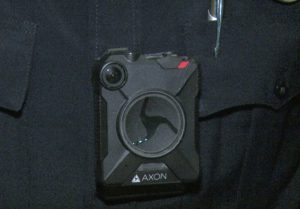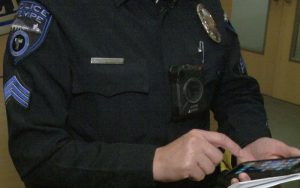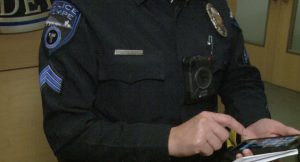- Slug: Body cameras. About 700 words.
- Photos available (thumbnails and captions below)
By NATALIE TARANGIOLI
Cronkite News
TEMPE – Police wearing body cameras can promote a good relationship between the community and police, including members of the public saying police officers treated them with respect, early results of an ongoing Arizona State University study show.
“Nearly 90 percent of the citizens strongly agreed the officers treated them with respect, treated them fairly, they were honest, they listened, they cared, and they acted professionally,” said Sgt. Josie Montenegro, a spokeswoman for Tempe police.
A research team found most of the 400 people surveyed rated their officer encounters as high in procedural justice, meaning how they were treated, said ASU professor Michael White, who is leading the two-year study. A foundation financed the nearly $500,000 study, which also funded the team to study body-cameras in Spokane, Wash.
“I’m curious to see in Tempe if there’s a temporary effect on complaints or if that reduction’s going to persist,” White said. The research team determined that the number of citizen complaints significantly dropped since the body-cameras were rolled out in 2015, White said, who is still analyzing the results for specific comparisons. )
Respondents were either victims, witnesses or alleged suspects of crimes that had interactions with Tempe police through 911 calls. They were asked as many as 53 questions over the phone and the research team did not know the nature of the contact with police, White said.
“How they felt they were treated, were they satisfied with the encounter,” White said. “Are they supportive of the technology, did they think it’s a good idea, do the benefits outweigh the costs? And then we would ask, ‘did you know you were recorded?’”
White’s team of graduate students spent six months researching and planning the Tempe Police Department study, with the first wave kicked off in November 2015 with 100 patrol officers, or about half of the patrol force. In May, the remaining 100 patrol officers started wearing cameras.
The two-phase process was to give the department time to try out the new technology and develop a policy.
Officer attitudes about body-worn cameras also were of interest, White said.
Some of the officers had concerns about using the cameras, such as how the community would act when they were worn and turned on, Sgt. Montenegro said.
Those concerns faded quickly.
“The cameras were a lot easier,” Sgt. Montenegro said. “The officers were pretty neutral in (that) they felt that people would be less aggressive, when they knew the officers had the cameras. But it really didn’t change too much once they had their cameras or not.”
Officers decided whether to turn on the cameras, which happened about 50 percent of the time, White said.
Steve Kilar, a spokesman for the American Civil Liberties Union of Arizona, said one of the biggest challenges with body-worn cameras is who controls when they’re turned off or on.
“So often, we see with dash cams, that those go on when lights and sirens are on,” Kilar said. “If a similar situation could be found for an automatic turn on for a body camera, say when there are raised voices or when there’s jostling of the police officer’s body, that may help us ensure that the most relevant portions of police interactions with citizens are recorded.”
Sgt. Montenegro said the department is working to encourage officers to turn on the cameras when enroute to a call to avoid forgetting to do so.
White said there was one negative in the survey – about 10 percent of those surveyed worried their privacy would be invaded by the body cameras. But that most respondents gave the encounters positive reviews was impressive.
“And that’s not the case in a lot of places across the country, so that’s a very, very positive finding for the police department,” White said.
The research team’s results have not yet been published online, White said, but they were presented in two public forums, one with The American Society of Criminology and at The International Association of Chiefs of Police meeting.
Besides training police to turn the cameras on more often, Tempe police are schooling the department and the public on why cameras are helpful.
The body cameras “promote greater transparency, and accountability; document evidence for criminal investigations and prosecutions, internal or administrative investigations, and civil litigation; Assist in resolving complaints against officers, including false allegations by members of the public; and enhance training,” a policy states.
^__=


